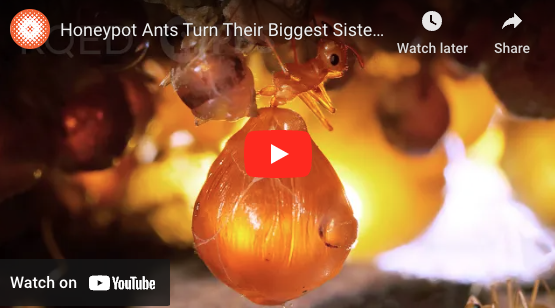Sought-After Scientific Authority: Professor Emeritus John R. Conway III, Ph.D.
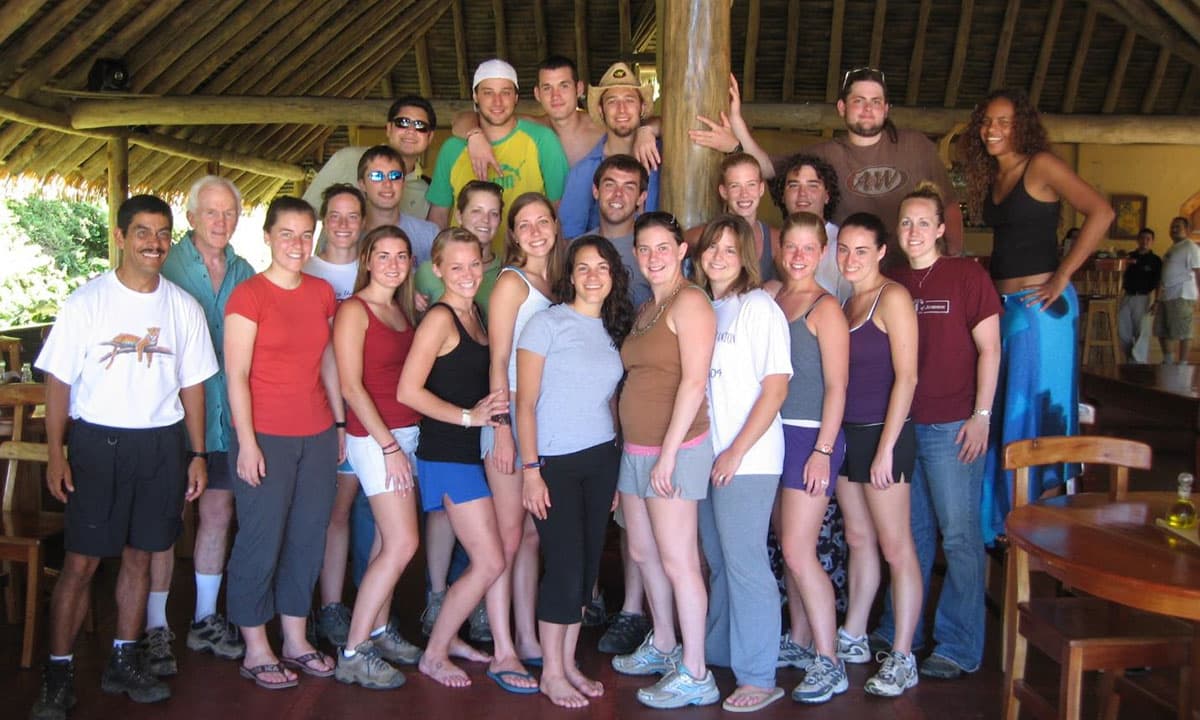
A few weeks before a global celebration of the environment, the University of Scranton Professor Emeritus John R. Conway III, Ph.D. will offer lifelong learners an insider perspective on some of the planet’s more unusual inhabitants.
The retired professor, who taught biology for 40 years at The University, will present an April 6 lecture at Fort Lewis College in Durango, Colorado on the captivating aspects of “The Incredible, Edible Honeypot Ant”.
He hopes to impart a broader message, which he described as “the diversity of species that evolved on earth and the increasing extinction of them due to human activity.” Dr. Conway will discuss the ecology and biology of the Myrmecocystus mexicanus, or honeypot ant, based on his comprehensive research in the Garden of the Gods, Colorado and the Southwestern Research Station in Arizona.
“Those of us who are biologists and naturalists realize that all forms of life on earth are interconnected and important for the health of the planet. In addition, they collectively are reservoirs of genetic diversity that often is beneficial to discoveries useful to humans,” said Dr. Conway.
“Our accelerating destruction of these forms of life threatens the existence of our planet and our species.”
That lesson is one that Dr. Conway presented to decades of students during his time at Scranton, through coursework and by leading numerous research trips to the Caribbean and Hawaii.
"One of the greatest aspects of leading tropical biology trips abroad with the University was that it allowed me to see students learning in a different light, outside the classroom. Every other year during intersession, we were in places such as Belize, Guatemala, Jamaica, Costa Rica and Panama. It was very rewarding," said Dr. Conway.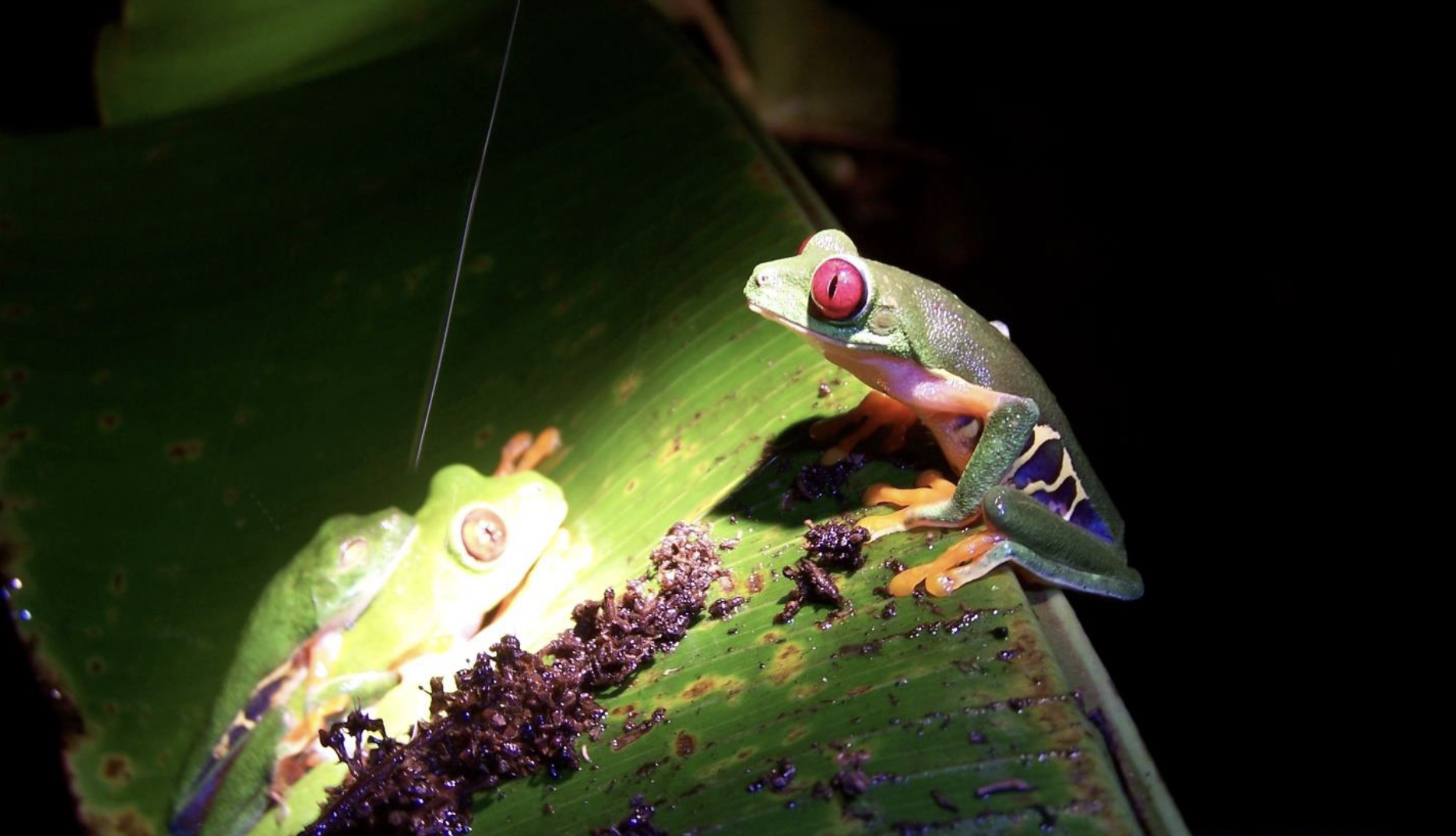
Red-eyed tree frog photographed during a University of Scranton tropical biology trip. Atlantica Lodge near Cahuita, Costa Rica, Jan. 13, 2007. Photo courtesy Dr. John R. Conway III
From high school physiology 'nerd' to sought-after Scientific authority
“As I reflect back ... I loved zoology in high school and even did time-consuming India ink drawings of animals in special classes before school. A friend and I were nerds and spent time at my house reviewing a physiology textbook during the summer. When I went to college at Ohio State University ... I first thought of being a pharmacist or veterinarian, but discovered I enjoyed and did well in the required biology courses....
I guess I finally decided that I should do what I most enjoyed, and that if I was successful, I could probably make a living. In my last year at Ohio State, I took summer field biology courses at the Stone Lab on an island in Lake Erie. I applied for a graduate school assistantship in biology at the University of Colorado in Boulder. I received word of acceptance while on the island.”
In 1975, Dr. Conway selected a doctoral thesis topic that retains relevance today -- honey ants -- whose workers live to eat, as much as possible, for the survival of the colony. Nearly 50 years later, he remains a sought-after authority on a type of self-sacrificing southwestern and Mexican honey ant.
In 2018, when he received a $30,000 grant to resume a study of the honey ant at The Garden of the Gods, he reflected on his choice in an interview with Royal News.
“I wanted something that was not only of academic interest, but also of popular interest. I was interested in photography and had National Geographic and other popular scientific magazines in mind. Fortunately, I have been able to achieve that,” said Dr. Conway at that time.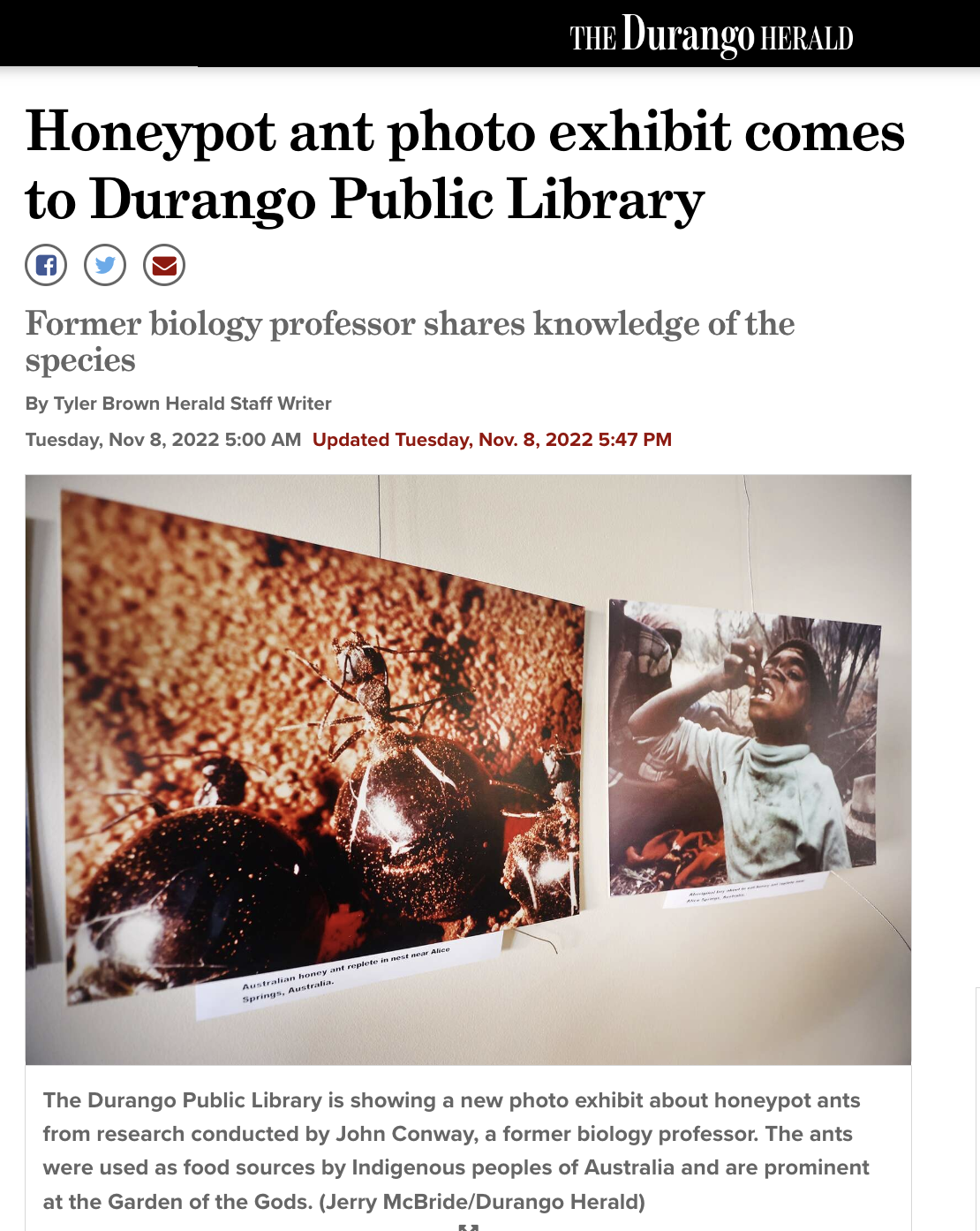
Excerpt from an article published Nov. 8, 2022 in The Durango Herald newspaper, Colorado. Herald Staff Writer Tyler Brown interviewed The University of Scranton Professor Emeritus John R. Conway III, Ph.D. (Photo: Jerry McBride/Durango Herald)
This past November, Dr. Conway's larger-than-life photo exhibit of honey ants at the Durango Public library garnered media attention from The Durango Herald, shown above.
Also in 2022, Dr. Conway received an invite to serve as a consultant for a PBS award-winning Deep Look nature series. He provided expert information and created diagrams for the KQED YouTube video feature by Gabriela Quiros, "Honeypot Ants Turn Their Biggest Sisters into Jugs of Nectar".
Honey ants: unusual, captivating and sweet
Dr. Conway describes four factors of honey ants that, over the years, he and his students have found most captivating about the unusual species:
- How unusual the honey ants are in lifestyle, appearance, and the uniqueness of their adaptation (formation of large repletes to store nectar).
- The fact that repletes sacrifice their lives to store food for the colony, hanging in complete darkness in underground special domed chambers their entire lives, and then die when they are depleted.
- The convergent evolution of the replete adaptation in two unrelated ants living in two widely separated areas of the world: Australia and North America.
- The convergent use of these sweet repletes by Australian Aborigines and early American Indians and the adoption of the honey ant as a totem by certain Australian tribes who developed songs, art, and cave paintings to depict them in their Dreamtime.
Up Next for University Professor Emeritus Dr. John R. Conway III?
Dr. Conway retired from the University in 2016, but not before leading research trips with students to the Caribbean and Hawaii and having traveled extensively throughout the world. Those experiences provide fodder for innumerable projects.
Climbing Kilimanjaro, hiking the Inca trail in Peru, and rafting the Futaleufu river in the Patagonia of Chile are among the adventures he plans to document and share. He shared a few that are planned for the near future, including lectures on past educational trips with University students and personal expeditions.
* A lecture on his research on the western thatching ant, Formica obscuripes, which he has observed for years at his family cabin near the West Elk Wilderness in Colorado.
“I secured a Howard Hughes grant and took several University of Scranton students there one summer to conduct a detailed study.”
* A LECTURE on his travels, including two overland truck camping expeditions, and photographs over the years in Africa (South Africa, Namibia, Botswana, Zimbabwe, Uganda, Kenya, Tanzania, Swaziland, Zaire).
"It would include personal adventures, such as rafting the Zambezi, climbing Kilimanjaro, and finding mountain gorillas in the Virunga Mountains of Zaire."
I plan to develop a talk on my travels in South America to Chile, Argentina, Ecuador, and Peru. It would include hiking the Inca trail in Peru, hiking in Torres del Paine National Park in Chile, and rafting the Futaleufu river in the Patagonia of Chile."
*A lecture based on his experiences and photographs in rainforests and coral reefs during his Tropical Biology courses taught between 1981 and 2014 in the Caribbean, Central America, and Hawaii.
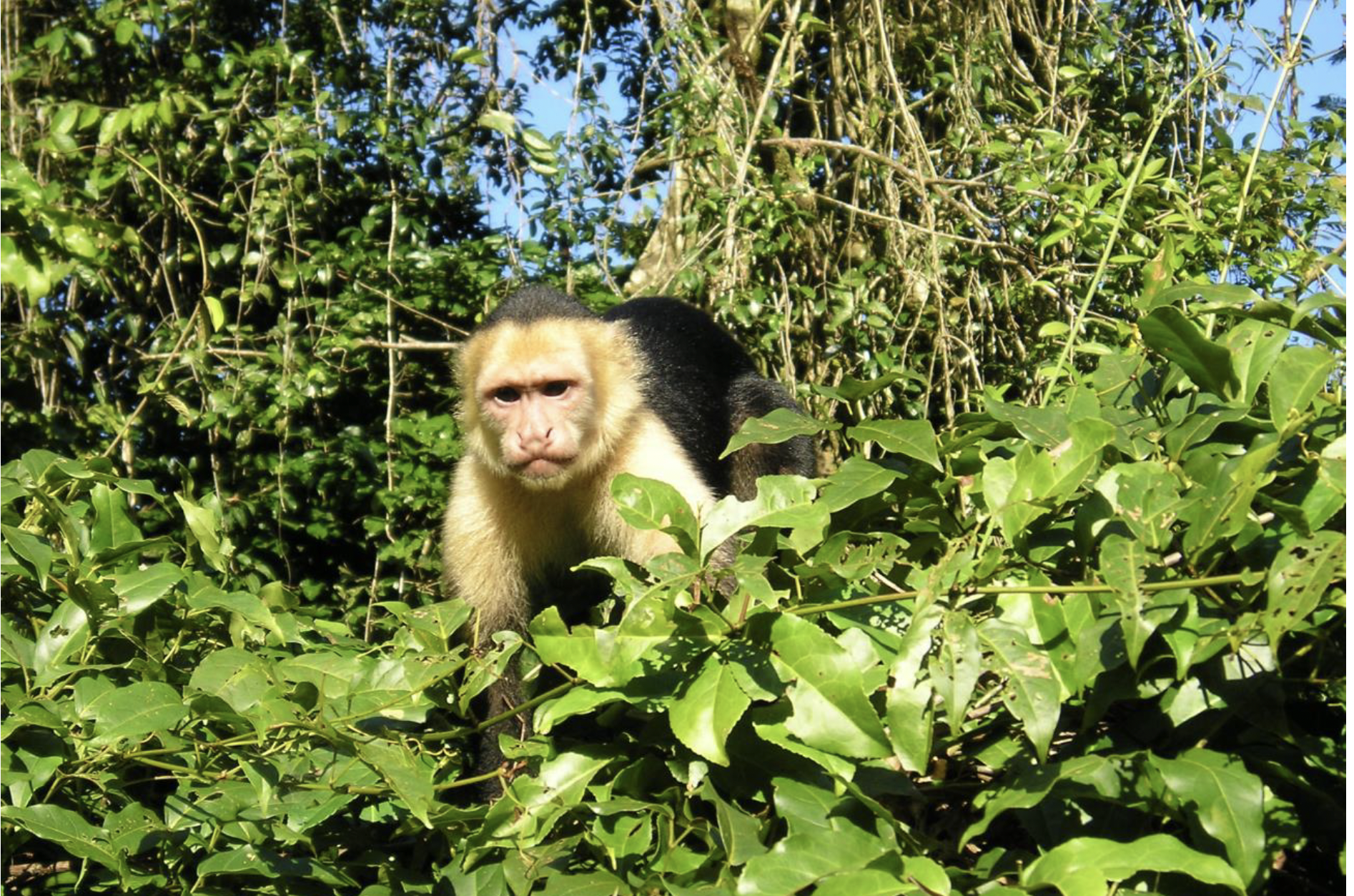
A white-faced capuchin monkey in Cahuita, Costa Rica, photographed during a University of Scranton tropical biology trip. Atlantica Lodge near Cahuita, Jan. 13, 2007. Photo courtesy Dr. John R. Conway III
One project remains at the forefront: A book on the biologists and naturalists who discovered the approximately 2 million known plant and animal species that constitute the Earth’s incredible biodiversity.
"I am conducting research to write a book and give lectures on the great naturalists of history. Currently, I have information on about 100 naturalists. At the moment, I am interested in the first expeditions and naturalists to visit the new lands in the Louisiana Purchase-Lewis and Clark, Zebulon Pike, the Stephen Long Expeditions."


